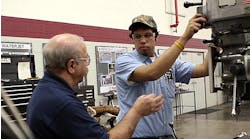Typically, when a year begins to wind down I work to draft a timely column, often drawing on my own philosophy that time is an artificial construct and years are no more (or less) relevant to gauging our success or failure than months or days, etc. But, just before time began to run short this year, I spent an hour with a man on the brink of retirement – and that has shifted my perspective.
Ron Gustafson sold Clinkenbeard & Associates last year, and retired in October after 34 years heading that company, a manufacturer of patterns, specialty castings, and complex machined parts. He'd been involved in patternmaking and the associated manufacturing fields for most of the past 50 years, and almost immediately I sensed he knew something that many long-timers never come to understand: "We have never believed that any system satisfies every job," he said. He carefully avoided speaking of himself, and consistently shared credit for the accomplishments of his long tenure. "You've got to have an open mind, and whatever approach is the best, then you definitely have to be open to that."
Gustafson started his working life as an apprentice patternmaker, and so not actually a "professional," but four years later he and a partner started a patternmaking business. Making patterns was, and is, demanding – requiring not only precision but responsiveness. Working with designers on one side and foundries on the other can be a no-win position.
But with that independent experience and some success, he invested in Clinkenbeard, a specialty patternmaking operation established by Hitchcock Industries to support its aircraft castings production. Hitchcock had provided all the shop's orders, advanced designs for customers like Hamilton Sundstrand and Woodward Governor, but the ownership change allowed Clinkenbeard to take on a wider variety of work from other industrial sectors.
Then, four years after the investment, Gustafson recalls taking his first view of a CNC machine at an exhibition. "It had twin tilting rotary tables on it," he said, "a large machine, probably 12- or 14-ft wide. Well, because I had gotten to know and understand a lot of the Sundstrand work, like fuel pumps and high-level pumping systems for aircraft, I had always been impressed with those impeller shapes, and I watched that CNC producing two at a time: they were big impellers, probably for Westinghouse air conditioners or something, probably a foot in diameter and a foot tall, and maybe 50 or 60 blades around them that were really wild shapes."
He noted those designs involved numerous shapes and details that patternmakers regularly execute to convert two-dimensional designs into casting patterns, details like drafts, radiuses, blends, and fillets. "And so I came away thinking that either we'll (patternmakers) have to learn how to do that, or the machinists could without a question do our work."
What happened then may not seem obvious, even today. Gustafson bought a CNC machine, and along with his patternmaking team learned the principles and skills of machining contoured patterns. The moment of recognition might have passed if he had not the strategic sense that the way a task is done is less critical than that it gets done well. He realized that designers, pattern shops, and foundries, as well as machine shops, are working toward the same goal from different perspectives and with different sets of expertise: they all want to transfer ideas into designs, and designs into complex objects that will fulfill the idea.
Having adopted CNC machining, Clinkenbeard developed a niche as a patternmaker that excelled at converting CAD designs into patterns, and that capability opened still another path into rapid prototyping. The successes never came immediately, and there was always room for doubt along the way. But, time proved the move into 3D design and manufacturing successful.
Gustafson told me he continues to believe there are technologies emerging or yet to be discovered that will transform design and manufacturing again. And he saluted the agility of manufacturers capable of adjusting strategies and programs to implement new production processes. He also expressed concern about the limits to progress, as he sees them, in organizations that resist innovative ideas because of cost or custom, and in regulatory agencies that discourage development out of allegiance to ideology.
What he did not express, but what became clear to me, was the important role of leadership in guiding progress. We don't need revolutionaries or iconoclasts, as our politics and culture so often insist: there is enough innovation and risk-taking in manufacturing today.
But progress and prosperity follow when good ideas are implemented with clarity, and just enough humility to know that there is more to success than personal gain. As another year closes and we continue to seek ways to achieve sustained economic growth, it's good to know there are reliable patterns for that.








